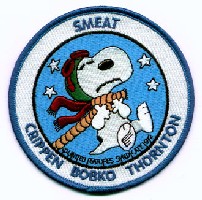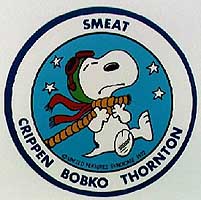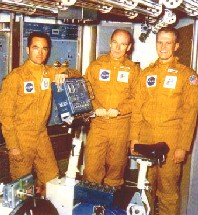

The Skylab Medical Experiment Altitude-chamber Test was a 56-day mission simulation conducted in a 6.1 meter (20 ft) diameter vacuum chamber. The interior of the chamber was configured closely to the Orbital Workshop crew quarters level which consisted of the medical experiments area, wardroom, waste management compartment, sleeping quarters, and recreational area. The atmosphere in the chamber was maintained at a composition identical to that of the Orbital Workshop, with 70 percent oxygen, 30 percent nitrogen mixture at a pressure of 34 X 10[3] Pa (5 Ib/in ). Carbon dioxide levels were controlled at a nominal level of 16.9 kP (5 in. Hg) pressure.
The prime objectives of the test were to acquire background dataand to exercise the data management and processing techniques for selected medical experiments. Other test objectives included the evaluation of medical experiment and operational equipment, the evaluation of operational procedures and the training of support personnel under simulated mission conditions.
Like a flight mission, the test consisted of a 21-day prechamber phase, a 56-day chamber test (from July 26 to September 19, 1972), and an 18-day postchamber test period. All preflight and postflight medical protocols were performed with astronaut crewmen. The inchamber test portion of the program was carried out using full mission simulation procedures, and included: crew checklist, real-time mission planning, and data management. The communications with the crewmen were limited to a spacecraft communicator, as programmed to be carried out in the mission. Simulated network communications were followed to evaluate the problems of lost communication between flight crew and mission control center, as they would be experienced in actual flight. A remote console was used by the medical team to evaluate the problems of lost communications and procedures for flight. This test program was successful; the required baseline data were obtained and the encountered equipment failures and problems were corrected prior to flight. The ground support personnel became an effective team ready to carry out the complex flight program.
The Artwork

According to correspondence exchanged with Robert Crippen and Karol Bobko, the crew worked with Schulz, who did the drawing. This particular image of Snoopy was chosen because he is trying to fly but is tied to the ground, a reference to their simulated mission.
The Crew

In the Summer of 1972 astronauts Robert Crippen, Karol Bobko and Bill Thornton spent 56 days in a Skylab mock-up at the Manned Spacecraft Center's altitude chamber to simulate the actual conditions that flight crews would experience in orbit. The test provided extensive medical data, but the mock-up did not contain duplicates of the experiments that would fly on Skylab and so the crew had plenty of time to read books, assemble model cars and learn how to speak Russian. Later Crippen and Bobko would perform support roles on the Apollo-Soyuz mission in 1975.